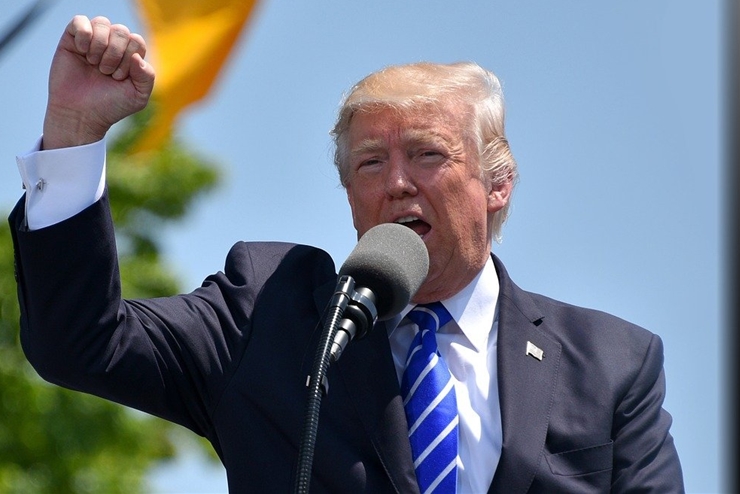If Donald Trump’s legion of enemies had the same grace they decry him for lacking, they would have had to admit that his re-election campaign was a bravura performance.
Facing the combined opposition of the media, academy, entertainment industry, permanent bureaucracy, tech monopolists, and big money generally, Donald Trump crisscrossed the country in the final few weeks before the election. He defied polls that showed him losing the national vote by 10 percent or so and losing the trio of states that sealed his victory four years ago—Pennsylvania, Michigan, and Wisconsin—by nearly as much. All this despite Biden’s big money donors vastly outspending Trump’s camp in key states.
Indeed, one poll taken on the eve of the election showed Trump down by 17 percent in Wisconsin. Yet Trump was indefatigable, speaking at multiple rallies every day, drawing large, enthusiastic crowds that reveled in his defiance of the people and institutions that have controlled the course of public life in America for decades.
The forces arrayed against Trump were so daunting that there was much talk on the left that this would be the election to ensure Democratic political dominance for a generation. Biden pointedly refused to rule out packing the Supreme Court, and Obama denounced the filibuster as a relic of Jim Crow. Other Democrats talked about giving statehood to Puerto Rico and the District of Columbia to give them four more safe seats in the Senate, and Democrats were nearly unanimous in their support for granting citizenship to millions of illegals, the majority of whom could be relied upon to vote for Democrats.
In order to achieve this revolution, though, Democrats needed both the House and the Senate, in addition to the White House. Instead, the Democrats lost House seats and failed to win enough seats on Election Day to tip the Senate. And, for a time, it appeared that Trump had somehow pulled it off: late into the night of Nov. 3, Trump had commanding leads in Pennsylvania and Michigan, and a smaller but still sizeable lead in Wisconsin.
Then, inexplicably, poll workers in Philadelphia, Milwaukee, Detroit, and Atlanta stopped counting votes. The election workers in those Democratic bastions apparently had better things to do on election night than count votes. The television announcers treated this as routine, but millions of dumbfounded viewers could not remember anything quite like it, and it proved fatal: while the nation slept, tens of thousands of Biden votes were found in each location. Just enough, interestingly enough, to give Biden a narrow victory in each state.
The revolution has been delayed, at least for a time. Even if Democrats succeed in winning both Senate seats in the December runoffs, which are required under Georgia law whenever the leading candidate gets less than 50 percent of the vote, West Virginia’s Democratic Senator Joe Manchin has indicated that he will vote against any plan to pack the Supreme Court or end the filibuster.
More importantly, Trump succeeded in increasing his popular vote total from 63 million in 2016 to 73 million in 2020. Although Biden won several million more, Trump’s 10 million vote improvement is still a considerable achievement. Those votes were cast in the face of a concerted effort to portray Trump as irredeemably evil, and in an environment in which many conservatives were fearful of expressing their views in public.
This willingness to defy suffocating conventional wisdom, even if only in the privacy of the voting booth, strongly suggests that the nationalist and populist themes that propelled Trump to victory in 2016, and to which he returned in the last few weeks of the campaign, have lost none of their potency. Indeed, Joe Biden felt the need to campaign as a protectionist in the industrial Midwest, and crafty Republican politicians sound far more like Donald Trump than like George W. Bush, Mitt Romney, or John McCain.
Indeed, if the Trump White House had not forgotten that the last election was won by a mere 77,000 votes scattered between Pennsylvania, Michigan, and Wisconsin, Trump would have won, in spite of everything. If Trump had secured a robust infrastructure bill, built the wall, and been as publicly solicitous of their votes as he was of minority voters, it is hard to imagine Trump’s share of white men without college degrees declining from 71 percent to 65 percent as it did from 2016 to 2020.
Since Trump won a higher percentage of minority and female voters in 2020 than in 2016, it was the small dip in support from the group at the very heart of his coalition that appears to have sunk him. Being as unashamed of courting these voters as Trump was of courting every other group will be the key to success for the next Republican looking to assume his mantle, especially as Democrats double down on critical race theory.
Image Credit:
above: President Donald J. Trump [Image by: Gerd Altmann from Pixabay ]

Leave a Reply